Ariens 991075 Owner's manual
- Category
- Utility Vehicle
- Type
- Owner's manual
This manual is also suitable for

MAX Zoom _"
Owner/Operator Manual
Models
991073 - Max Zoom 48
991074 - Max Zoom 52
991075 - Max Zoom 60
_ _ ENGLISH
FRAN(_AIS
03994900 10/09
Printed in USA

InuP'__-1nil= [o_ [_o] _,lnul__,ln_
Safety ........................... 4
Assembly ........................ 9
Controls and Features ............. 11
Operation ....................... 12
Maintenance Schedule ............ 16
Service and Adjustments .......... 18
Storage ......................... 30
Accessories ..................... 31
Service Parts .................... 31
Specifications ................... 32
Warranty ........................ 33
II_/ J;_o]_li_o,]i_o]_I
NON-ENGLISH MANUALS
Manuals in languages other than
_, nglish may be obtained from your
Dealer. Visit your dealer or
www.ariens.com for a list of
-_ languages available for your
equipment.
Manuals printed in languages other
than English are also available as a
free download on our website:
htt p://www.ariens.co m
MANUALES EN IDIOMAS
DIFERENTES DEL INGLES
Puede obtener manuales en
idiomas diferentes del ingles en su
distribuidor. Visite a su distribuidor
o vaya a www.ariens.com para
obtener una lista de idiomas
disponibles para su equipo.
Tambien puede imprimir manuales
en idiomas diferentes del ingles
descargandolos gratuitamente de
nuestra pagina Web:
htt p://www.ariens.co m
MANUELS NON ANGLAIS
Des manuels dans differentes
langues sont disponibles chez
votre revendeur. Rendez-vous
chez votre revendeur ou allez sur
le site www.ariens.com pour
consulter la liste des langues
disponibles pour votre equipement.
Les manuels imprimes dans des
langues differentes de I'anglais
sont egalement disponibles en
telechargement gratuit sur notre
site Web :
htt p://www.ariens.co m
THE MANUAL
Before operation of unit, carefully and
completely read your manuals. The contents
will provide you with an understanding of
safety instructions and controls during normal
operation and maintenance.
All reference to left, right, front, or rear are
given from operator sitting in the operation
position and facing the direction of forward
travel.
SERVICE AND REPLACEMENT
PARTS
When ordering publications, replacement
parts, or making service inquiries, know the
Model and Serial numbers of your unit and
engine.
Numbers are located on the product
registration form in the literature package.
They are printed on a serial number label,
located on the frame of your unit (Figure 1).
Serial Number Label
OF4300
Figure 1
GB-2

•RecordUnitModelandSerialnumbers
here.
[
• Record Engine Model and Serial numbers
here.
[
PRODUCT REGISTRATION
The Ariens dealer must register the product
at the time of purchase. Registering the
product will help the company process
warranty claims or contact you with the latest
service information. All claims meeting
requirements during the limited warranty
period will be honored, whether or not the
product registration card is returned. Keep a
proof of purchase if you do not register your
unit.
Customer Note: If the Dealer does not
register your product, please fill out, sign and
return the product registration card to Ariens
or go to www.ariens.com on the internet.
UNAUTHORIZED REPLACEMENT
PARTS
Use only Ariens replacement parts. The
replacement of any part on this equipment
with anything other than an Ariens authorized
replacement part may adversely affect the
performance, durability, and safety of this unit
and may void the warranty. Ariens disclaims
liability for any claims or damages, whether
regarding warranty, property damage,
personal injury or death arising out of the use
of unauthorized replacement parts.
NOTE: To locate your nearest Ariens Dealer,
go to www.ariens.com.
DISCLAIMER
Ariens reserves the right to discontinue,
change, and improve its products at any time
without public notice or obligation to the
purchaser. The descriptions and
specifications contained in this manual were
in effect at printing. Equipment described
within this manual may be optional. Some
illustrations may not be applicable to your
unit.
DEALER DELIVERY
Dealer should:
1. Test brakes after unit is assembled to be
sure adjustment has not been disturbed
in shipment (See Parking Brake
Interlock System on page 12). Wheel
brakes are properly adjusted at factory.
2. Check the safety interlock system to
make sure that it is functioning properly.
With operator on seat, unit must not start
unless steering levers are in neutral (N)
and Power Takeoff (PTO) is disengaged
(Off). Engine must stop if operator
leaves seat when steering levers are in
any drive position or PTO is engaged
(On). See Safety Interlock System on
page 12.
3. Fill out Original Purchaser Registration
Card and return the card to Ariens.
4. Explain Limited Warranty Policy.
5. Explain recommended lubrication and
maintenance. Advise customer on
adjustments. Instruct customer on
controls and operation of unit. Discuss
and emphasize the Safety Precautions.
Give customer Owner/Operator, Parts,
and Engine Manuals. Advise customer
to thoroughly read and understand them.
Customer Note: Your Dealer has been
provided complete set-up and preparation
instructions which must be completed prior to
you taking delivery of this unit. The dealer is
required to review important information in
this manual with you before or upon delivery
of the unit or attachment.
GB-3

[,."Y-,1_1=1i'd
WARNING: This cutting machine
is capable of amputating hands
and feet and throwing objects.
Failure to observe the safety
instructions in the manuals and
on decals could result in serious
injury or death.
Slopes are a major factor related
to loss-of-control and tip-over
accidents. Operation on all slopes
requires extra caution.
Tragic accidents can occur if the
operator is not alert to the
presence of children. Never
assume that children will remain
where you last saw them.
Gasoline is extremely flammable
and the vapors are explosive,
handle with care.
Disengage attachment, stop unit
and engine, remove key, engage
parking brake, and allow moving
parts to stop before leaving
operator's position.
OL1253
01_3900
SAFETY ALERT
SYMBOL
These are safety alert
symbols They mean:
,ATTENTION!
•YOUR SAFETY IS
INVOLVED!
When you see this symbol:
•BECOME ALERT!
•OBEY THE MESSAGE!
SIGNAL WORDS
The safety alert symbols above and signal
words below are used on decals and in this
manual.
Read and understand all safety messages.
DANGER: IMMINENTLY
HAZARDOUS SITUATION! If not
avoided, WILL RESULT in death
or serious injury.
WARNING: POTENTIALLY
,_ HAZARDOUS SITUATION! If not
avoided, COULD RESULT in
death or serious injury.
CAUTION: POTENTIALLY
HAZARDOUS SITUATION! If not
avoided, MAY RESULT in minor or
moderate injury. It may also be
used to alert against unsafe
practices.
NOTATIONS
NOTE: General reference information for
proper operation and maintenance practices.
IMPORTANT: Specific procedures or
information required to prevent damage to
unit or attachment.
PRACTICES AND LAWS
Practice usual and customary safe working
precautions, for the benefit of yourself and
others. Understand and follow all safety
messages. Be alert to unsafe conditions and
the possibility of minor, moderate, or serious
injury or death. Learn applicable rules and
laws in your area, including those that may
restrict the age of the operator.
REQUIRED OPERATOR
TRAINING
Original purchaser of this unit was instructed
by the seller on safe and proper operation. If
unit is to be used by someone other than
original purchaser (loaned, rented or sold),
ALWAYS provide this manual and any
needed safety training before operation.
SAFETY DECALS AND
LOCATIONS
ALWAYS replace missing or damaged Safety
Decals. Refer to Figure 2 for Safety Decal
locations.
GB-4

Figure2
OF1625
• DANGER! TO AVOID SERIOUS
INJURY OR DEATH
Read Owner/Operator Manual.
OL180I
I0 ee chi'drenandothersawa
• from unit while operating.
01_4370
Never direct discharge toward
other people. Thrown objects
can cause injury. Remove
objects that could be thrown by
the blade.
0L0910
0L4460
0L4470
Look down and behind before
and while backing.
Keep children out of work area
and under watchful care of a
responsible adult.
NEVER CARRY CHILDREN.
Go up and down slopes, not
across.
DO NOT operate on slopes
over 10°.
OL4450
If machine stops going uphill, stop
blade and back down slowly.
Avoid sudden turns.
Keep safety devices (guards, shields,
switches, etc.) in place and working.
Check interlock system per manual
before use.
Understand location and function of all
controls.
Never allow operation by untrained
persons.
2. DANGER! ROTATING PARTS
OL3030
OL0910
Always keep feet and hands
away from rotating parts.
Always stand clear of discharge
area. Do not direct discharge
toward other people.
Keep people away from unit
_ while operating.
OL3292
OL4480
GB-5

Shutoffengine,removekey,
readmanualbeforeyouadjust
orrepairunit.
OL4010
NO STEP! Always keep feet
_--_ away from rotating parts.
OL4420
3. WARNING!
Do not operate mower unless guards are in
operating position or bagger is attached.
Always stand clear of discharge
,_ area.
OL4430
OL3320
Do not operate mower unless
bagger is attached or guards
are in operating position.
4. HOT SURFACES!
OS073I
DO NOT touch parts which
are hot from operation.
ALWAYS allow parts to cool.
5. ROTATING PARTS
AVOID INJURY. Stay clear of
rotating parts.
OF3450
6. DANGER!
AVOID INJURY. Stay clear of
rotating parts.
©L4730
SAFETY RULES
Read, understand, and follow all safety
practices in Owner/Operator Manual before
beginning assembly. Failure to follow
instructions could result in personal injury
and/or damage to unit.
ALWAYS remove key and/or wire from spark
plug before assembly. Unintentional engine
start up can cause death or serious injury.
Complete a walk around inspection of unit
and work area to understand:
• Work area • Your unit • All safety decals
Determine which attachments are needed
and can be used safely.
Inspect unit before each use for: missing or
damaged decals and shields, correctly
operating safety interlock system, and
deterioration of grass catchers. Replace or
repair as needed.
ALWAYS check overhead and side
clearances carefully before operation.
ALWAYS be aware of traffic when operating
along streets or curbs.
Keep children and people away.
Keep children out of work area and under
watchful care of a responsible adult.
Keep area of operation clear of all toys, pets,
and debris. Thrown objects can cause injury.
Check for weak spots on docks, ramps or
floors. Avoid uneven work areas and rough
terrain. Stay alert for hidden hazards or traffic.
DO NOT operate near drop-offs, ditches, or
embankments. Unit can suddenly turn over if
a wheel is over the edge of a cliff or ditch, or if
an edge caves in.
Data indicates that operators, age 60 and
above, are involved in a larger percentage of
riding mower related injuries. These
operators should evaluate their ability to
operate the riding mower safely enough to
protect themselves and others from serious
injury.
Read the entire Owner/Operator manual and
other training material. If the operator or the
mechanic cannot read the manual, it is the
owner's responsibility to explain it to them.
Only the user can prevent and is responsible
for accidents or injuries occurring to
themselves, other people or property.
Only trained adults may operate or service
unit. Training includes actual operation.
Local regulations may restrict the age of the
operator.
NEVER allow children to operate or play on
or near unit. Be alert and shut off unit if
children enter area.
NEVER operate unit after or during the use of
medication, drugs or alcohol. Safe operation
requires your complete and unimpaired
attention at all times.
GB-6

DONOTwearlooseclothingorjewelryand
tiebackhairthatmaygetcaughtinrotating
parts.
Wearadequateoutergarments.
NEVERwearopensandalsorcanvasshoes
duringoperation.Wearadequatesafetygear,
protectiveglovesandfootwear.
Wearproperfootweartoimprovefootingon
slipperysurfaces.
Alwayswearsafetygogglesorsafetyglasses
withsideshieldswhenoperatingmower.
Movingpartscancutoramputatefingersora
hand.Wrapblade(s)orwearglovesto
service.Onmultiblademowers,rotationof
onebladewillcauseallbladestorotate.
NEVERplaceyourhandsoranypartofyour
bodyorclothinginsideornearanymoving
partwhileunitisrunning.
ALWAYSkeephandsandfeetawayfromall
rotatingpartsduringoperation.Rotatingparts
cancutoffbodyparts.
ALWAYSkeepbodyandhandsawayfrom
pinholesornozzleswhichejecthydraulic
fluidunderpressure.
DONOTtouchpartswhicharehot.Allow
partstocool.
ALWAYSkeephandsandfeetawayfromall
pinchpoints.
Fumesfromtheengineexhaustcancause
deathorseriousinjury.DONOTrunenginein
anenclosedarea.Alwaysprovidegood
ventilation.
Read,understand,andfollowallinstructions
inthemanualandonthemachinebefore
starting.Understand:
Howtooperateallcontrols
Thefunctionsofallcontrols
HowtoSTOPinanEmergency
Brakingandsteeringcharacteristics
Turningradiusandclearances
Keepsafetydevicesorguardsinplaceand
functioningproperly.NEVERmodifyor
removesafetydevices.
Donotoperatewithouteitherentiregrass
catcherorthedischargeguardinplace.
Stopenginebeforeremovinggrasscatcheror
uncloggingchute.
EnsureSafetyInterlockSystemisfunctioning
properly.DONOToperateunitifsafety
interlockisdamagedordisabled.
Startandoperateunitonlywhenseatedin
operator'sposition.Steeringcontrollevers
mustbeinneutral,PTOdisengagedand
parkingbrakesetwhenstartingengine.
Usecarewhenapproachingblindcorners,
shrubs,treesorotherobjectsthatmay
obscurevision.
Dust,smoke,fog,etc.canreducevisionand
causeanaccident.Mowonlyindaylightor
goodartificiallight.
Avoidslipperysurfaces.Alwaysbesureof
yourfooting.
DONOTmowonwetgrass.Reduced
tractioncouldcauseslidingandeffectthe
machine'sstability.
Watchfortrafficwhenoperatingnearor
crossingroadways.
Nevercarrypassengers.
DONOTtrytostabilizethemachineby
puttingyourfootontheground.
Neverdirectdischargetowardspersonsor
propertythatmaybeinjuredordamagedby
thrownobjects.Useextremecautionon
gravelsurfaces.
Alwaysstandclearofthedischargearea.
ALWAYSdisengagePTO,stopunitand
engine,removekey,engageparkingbrake
andallowmovingpartstostopbeforeleaving
operator'sposition.
NeverengagePTOwhileraisingattachment
orwhenattachmentisinraisedposition.
DONOToperateattoofastarate.DONOT
changeenginegovernorsettingsorover-
speedengine.Slowdownbeforeturning.
DONOToperateinreverseunlessabsolutely
necessary.ALWAYSlookdownandbehind
beforeandwhilebacking.
Stopandinspectequipmentifyoustrikean
objectorifthereisanunusualvibration.
Repair,ifnecessary,beforerestarting.Never
makeadjustmentsorrepairswiththeengine
running.
Mowerbladesaresharpandcancutyou.
Wraptheblade(s)orweargloves,anduse
extracautionwhenservicingthem.NEVER
weldorstraightenmowerblades.
Rotationofoneblademaycauserotationof
theotherblades.
Takeallpossibleprecautionswhenleaving
unitunattended.Shutoffengine.Remove
wirefromsparkplugandsecureitawayfrom
sparkplug.
ALWAYSremovekeytopreventunauthorized
use.
Know the weight of loads. Limit loads to those
you can safely control and the unit can safely
handle.
GB-7

DisengagePTOwhenattachmentisnotin
use.ALWAYSturnoffpowertoattachment
whentravelling,crossingdriveways,etc.
Mowupanddownslopes,notacrossthem.
DONOToperateonslopesofmorethan17
degrees.
UseofaRolloverProtectionSystem(ROPS)
isrecommendedforslopeoperation.See
AttachmentsandAccessories.
Alwayswearaseatbeltwhenoperatingunit
usingaRolloverProtectionSystem(ROPS).
Keepallmovementsontheslopeslow and
gradual. Do not make sudden changes in
speed or direction.
Avoid starting or stopping on the slope. If tires
lose traction, disengage the blades and
proceed slowly straight down the slope.
If you cannot back up a slope or you feel
uneasy on it, do not mow it.
DO NOT park on slopes unless necessary.
When parking on slope always chock or block
wheels. Always set parking brake.
Use a slow speed. Tires may lose traction on
slopes even though the brakes are
functioning properly.
Do not bypass transmission when on a slope.
Tow only with a machine that has a hitch
designed for towing. Do not attach towed
equipment except at the hitch point.
Follow the manufacturer's recommendations
for weight limits for towed equipment and
towing on slopes.
NEVER allow children or others in or on
towed equipment.
On slopes, the weight of the towed equipment
may cause loss of control.
Travel slowly and allow extra distance to stop.
Use extra care when loading or unloading
unit onto trailer or truck.
Secure unit chassis to transport vehicle.
NEVER secure from rods or linkages that
could be damaged.
DO NOT transport machine while engine is
running.
ALWAYS turn off power to attachment and
shut off fuel when transporting unit.
Keep unit free of debris. Clean up oil or fuel
spills.
This product is equipped with an internal
combustion type engine. DO NOT use unit on
or near any unimproved, forest-covered or
brush covered land unless exhaust system is
equipped with a spark arrester meeting
applicable local, state or federal laws. A spark
arrester, if it is used, must be maintained in
effective working order by operator.
Fuel is highly flammable and its vapors are
explosive. Handle with care. Use an
approved fuel container.
NO smoking, NO sparks, NO flames.
ALWAYS allow engine to cool before
servicing.
NEVER fill fuel tank when engine is running
or hot from operation.
NEVER fill or drain fuel tank indoors.
Replace fuel cap securely and clean up
spilled fuel.
Never fill containers inside a vehicle or on a
truck or trailer bed with a plastic liner. Always
place containers on the ground away from
your vehicle before filling.
When practical, remove gas-powered
equipment from the truck or trailer and refuel
it on the ground. If this is not possible, then
refuel such equipment on a trailer with a
portable container, rather than from a
gasoline dispenser nozzle.
Keep the nozzle in contact with the rim of the
fuel tank or container opening at all times until
fueling is complete. Do not use a nozzle lock-
open device.
If fuel is spilled on clothing, change clothing
immediately.
Avoid Electric Shock. Objects contacting both
battery terminals at the same time may result
in injury and unit damage. DO NOT reverse
battery connections.
Reverse connections may result in sparks
which can cause serious injury. Always
connect positive (+) lead of charger to
positive (+) terminal, and negative (-) lead to
negative (-) terminal.
ALWAYS disconnect negative (-) cable FIRST
and positive (+) cable SECOND. ALWAYS
connect positive (+) cable FIRST, and
negative (-)cable SECOND.
Explosive Gases from battery can cause
death or serious injury. Poisonous battery
fluid contains sulfuric acid and its contact with
skin, eyes or clothing can cause severe
chemical burns.
No flames, No sparks, No smoking near
battery.
GB-8

ALWAYSwearsafetyglassesandprotective
gearnearbattery.Useinsulatedtools.
DONOTTIPbatterybeyonda45°anglein
anydirection.
ALWAYSkeepbatteriesoutofreachof
children.
Batteryposts,terminalsandrelated
accessoriescontainleadandlead
compounds,chemicalsknowntotheStateof
Californiatocausecancerandreproductive
harm.Washhandsafterhandling.
ALWAYSblockwheelsandknowalljack
standsarestrongandsecureandwillhold
weightofunitduringmaintenance.
Releasepressureslowlyfromcomponents
withstoredenergy.
NEVERattempttomakeanyadjustmentsto
unitwhileengineisrunning(exceptwhere
specificallyrecommended).Stopengine,
removekeyorsparkplugwireandwaitforall
movingpartstostopbeforeservicingor
cleaning.
Checkparkingbrakeoperationfrequently.
Adjustandserviceasrequired.
ALWAYSmaintainunitinsafeoperating
condition.Damagedorwornoutmufflercan
causefireorexplosion.
Maintainorreplacesafetyandinstruction
labels,asnecessary.
NEVERstoreunitwithfuelinfueltank,inside
abuildingwhereanyignitionsourcesare
present.
Shutofffuelandallowenginetocool
completelybeforestoringinclosedareaor
coveringunit.
Cleangrassanddebrisfromunit,especially
fromaroundmufflerandengine,tohelp
preventfires.
Forextendedstorage,shutofffuelandclean
unitthoroughly.Seeenginemanualforproper
storage.
Lowercuttingdeckunlessapositive
mechanicallockisused.
Useonlyattachmentsoraccessories
designedforyourunit.
Checkallhardwareatregularintervals,
especiallybladeattachmentbolts.Keepall
hardwareproperlytightened.
=1 :]wl
A
WARNING: AVOID INJURY.
Read and understand entire
Safety section before proceeding.
UNIT ASSEMBLY
Package Contents:
Unit,Mower Deck and Literature Pack
Preparation Checklist
Refer to the Owner/Operator manual as
required.
1. Unpack Unit - Remove shrink wrap and
packaging materials.
2. Remove Unit From Container - Open
Bypass Valves (dump valves) (See
Moving the Unff with the Engine Off on
page 15).
Push unit from container onto a level
surface. Close the bypass valves.
3. Tires - See Specifications on page 32.
A
CAUTION: Avoid injury! Explosive
separation of tire and rim parts is
possible when they are serviced
incorrectly:
Do not attempt to mount a
tire without the proper
equipment and experience
to perform the job.
Do not inflate the tires
above the recommended
pressure.
Do not weld or heat a wheel
and tire assembly. Heat can
cause an increase in air
pressure resulting in an
explosion. Welding can
structurally weaken or
deform the wheel.
Do not stand in front or over
the tire assembly when
inflating. Use a clip-on
chuck and extension hose
long enough to allow you to
stand to one side.
GB-9

4.Seat-SeeSeat Adjustments on
page 13 and Service Position on
page 18.
5. Position Steering Levers - Remove
eccentric spacers and rotate steering
levers to the operating position. Reinstall
spacers. Tighten hardware securely.
See Aligning the Steering Levers
(Figure 14) on page 23.
2 1
3
1. Steering
Levers
2. Seat
Figure 3
Mounting
Hardware
©F4110
6. Battery - Remove battery from unit and
charge (See Battery on page 21).
7. Check Engine Crankcase - Check and
add oil if needed. See Engine Manual for
specifications.
8. Fill Engine Fuel Tank - Add clean fuel to
the fuel tank.
NOTE: See engine manual for fuel type.
9. Hardware - Check for loose hardware.
10. Check Safety Interlock System - Check
to see that the interlock system operates
correctly (See Safety Interlock System
on page 12).
WARNING: FAILURE OF
INTERLOCK together with
improper operation can result in
severe personal injury.
11. Lubrication - Lubricate all fittings per
maintenance label under seat and check
hydrostat oil level (See Ariens does not
recommend jump-starting your unit.
Jump-starting can damage engine and
electrical system components. See your
engine manual for more detailed
information, on page 22).
12. On 60-inch Decks: Remove the
discharge chute from the transport
position and place the discharge chute
in the operating position.
13. Level Deck - Check unit to ensure deck
level set at factory has been maintained
(See Leveling the Mower Deck on
page 28).
14. Check Function of all Controls- Ensure
unit runs and performs properly.
WARNING: FAILURE OF
_, CONTROLS could resultin death
or serious injury.
GB - 10

[o_o_o_,,."] _-'N_IJ]I_ __,_nnLU_t_'!
16
14
11
OF_lO
OF4_O
13
12
Figure 4
1. Fuel Tanks and Caps
2. Steering Levers
3. Hydraulic Oil Reservoir
4. Ignition Switch
5. Hour Meter
6. Throttle Lever
7. Choke Control
8. Power Take Off (PTO) Switch
9. Battery
10. Fuel Shut Off Valve
11. Mower Lift Pedal
12. Mower Deck
13. Mower Lift Lock
14. Seat Adjustment Lever
15. Parking Brake
16. Bypass Valve Lever
GB- 11

Eel_ :1-':r_,_lIIICe]_I
WARNING: AVOID INJURY.
Read and understand entire
Safety section before proceeding.
CONTROLS AND FEATURES
See Figure 4 for Controls and Features
locations.
Safety Interlock System
WARNING: Safety interlock
system failure and improper
operation of unit can result in
death or serious injury. Test this
system each time the unit is
operated. If this system does not
function as described, do not
operate until repairs are made.
Perform the following tests to ensure the
safety interlock system is working properly. If
the unit does not perform as stated, contact
your Ariens dealer for repairs.
NOTE: When the parking brake is engaged,
the steering levers are locked in neutral.
Test SteeringLeversPTO BrakeParkingEngine
STARTING INTERLOCK
Neutral Off Engaged Starts
2 Neutral On Engaged Doesn't
Start
3 Neutral Off Dis- Doesn't
engaged Start
OPERATING INTERLOCK (ENGINE ON)
4" Neutral On Engaged Shuts Off
5* Neutral Off Dis- Shuts Off
engaged
Operator lifts off seat.
Parking Brake Interlock System
With the parking brake engaged, the steering
levers must be locked in neutral.
With the parking brake disengaged, the
engine must not start and the engine must
shut off if the operator leaves the seat.
Steering Levers
A
C
B
D
The steering levers control speed and
direction. In addition, they will stop the unit.
A. For reverse travel, pull both steering
control levers backward.
B. For straight forward travel, push both
steering control levers forward.
C. To turn left, pull the left back or push
the right steering control lever forward
or a combination of both.
D. To turn right, pull the right back or
push the left steering control lever
forward or a combination of both.
To stop, return both steering levers to neutral.
NOTE: The steering controls are
mechanically locked in neutral whenever the
parking brake is engaged.
NOTE: Aggressive turning can scuff or
damage lawns. ALWAYS keep both wheels
rotating when making sharp turns. DO NOT
make turns with inside wheel completely
stopped. To obtain minimum turning radius,
slowly reverse inside wheel while moving
outside wheel slowly forward.
Ignition Switch
Operate the ignition switch
with the removable key.
The switch has three
positions: Off (1), On (2)
and Start (3). To start the
engine, turn the key to
Start, then release to On.
To stop the engine, turn
the key to Off.
Choke Control
Push the choke lever
forward to start a cold
engine. Pull the choke
lever to the rear when the
engine gets warm.
GB - 12

!
M
§ lm)lJI
2
OF1700
Drive
Neutral
Throttle Lever
The throttle lever changes
the engine speed. Move
the throttle lever to Fast (1)
to increase engine speed.
Move the lever to Slow (2)
to decrease engine speed.
Bypass Valve Lever
Pull the lever back to set
the pump in neutral and
move the unit with the
engine off.
Push the lever in to set the
pump in the drive position
and operate the unit.
ON
OFF 0E026I
Power Take Off (PTO)
Switch
Power take off (PTO)
switch engages and
disengages the mower
blades.
Pull the power take off
(PTO) switch to "On"
position to engage mower
blades.
Push the power take off
(PTO) switch to "Off" position to disengage
mower blades.
NOTE: The engine will not start unless the
steering control levers are in the neutral
position, the PTO switch is in the "Off"
position and parking brake is set.
Mower Lift Pedal
OF1700
Mower lift pedal raises and lowers mower
deck for mowing or transport.
Transport:
Push mower lift pedal all the way forward until
lift lock engages.
Cutting Height:
Put cutting height adjustment pin in desired
hole. Push mower lift pedal forward and hold
it while pushing down on the lift lock. Slowly
lower mower lift pedal until deck lift contacts
cutting height adjustment pin.
Fuel Shut-Off Valve
Use this valve to control
fuel flow from left or right
fuel tank.
Open the valve to operate
the engine. Turn the valve
to "Off" when storing or
transporting the unit.
I_(Q)÷
"_OF1740
Parking Brake Lever
1. Pull lever up to engage
parking brake.
2. Push lever down to
disengage parking brake.
Seat Adjustments
_ ARNING: Make all seat
adjustments with unit stationary,
parking brake on and engine shut
off.
To adjust seat forward or backward:
1. While seated, pull seat adjustment lever
outward and slide seat into desired
position.
2. Release lever and slide seat forward or
back to lock seat into position.
Hour Meter
Records total number of
hours the engine has
been run.
IMPORTANT: Keep a
record of Hour Meter
readings for
recommended Lubrication
and Maintenance
intervals.
NOTE: For accurate readings be sure Ignition
Switch is OFF when unit is not in operation.
GB - 13

FILLING FUEL TANK
WARNING: AVOID INJURY.
Read and understand entire
Safety section before proceeding.
Add fuel to Fuel Tank as needed. See your
Engine Manual for correct type and grade of
fuel.
To add fuel to the fuel tank:
1. Place unit in an open or well-ventilated
open area.
2. Stop the engine and allow it to cool.
3. Clean the fuel cap and the area around
the fuel cap to prevent dirt from entering
the fuel tank. Remove the cap from the
fuel tank.
4. Fill the fuel tank to within 1 in. (25 mm)
below bottom of filler neck.
5. Replace fuel cap and tighten.
6. Clean up any spilled fuel.
GASOLINE
IMPORTANT: ALWAYS use gasoline that
meets the following guidelines:
Clean, fresh gasoline.
A minimum of 87 octane/87 AKI (91
nON). High altitude use may require a
different octane. Consult your engine
manual.
Gasoline with up to 10% ethanol
(gasohol) or up to 15% MTBE (methyl
tertiary butyl ether) is acceptable.
Use of any gasoline other than those
approved above may void the engine
warranty. If the pumps are not marked
for the content of alcohol or ethers,
check ethanol and MTBE levels with
the fuel supplier.
Do not modify the fuel system to use
different fuels.
Never mix oil and gasoline.
NOTE: All gasoline is not the same. If the
engine experiences starting or performance
problems after using a new gasoline, switch
to a different fuel provider or fuel brand.
IMPORTANT: Excessively oxygenated or
reformulated fuels (fuels blended with
alcohols or ethers) can damage the fuel
system or cause performance problems. If
any undesirable operating problems occur,
use a gasoline with a lower percentage of
alcohol or ether.
Fuel Stabilizer
Gasoline left in the fuel system for extended
periods without a stabilizer will deteriorate,
resulting in gum deposits in the system.
These deposits can damage the carburetor
and the fuel hoses, filter and tank. Prevent
deposits from forming in the fuel system
during storage by adding a quality fuel
stabilizer to the fuel. Follow the
recommended mix ratio found on the fuel
stabilizer container.
PRE-START
,_ CAUTION: Make sure all
hardware is tight, all safety
devices are in place and all
adjustments are made correctly.
1. Check Safety Interlock System
If this system does not function as described
do not operate until repairs are made.
2. Check Air Cleaner
Check air filter for dirt. Clean as required.
Follow Engine Manual Maintenance
Schedule.
3. Check Engine Fuel and Crankcase
Oil
Check and add fuel if required. Check that
engine crankcase oil is full. Follow Engine
Manual Maintenance Schedule.
4. Check Tire Pressure
See Specifications on page 32 for correct tire
pressure.
5. Check Hydraulic Fluid Level
See Check Hydraulic Fluid Level on page 19.
6. Adjust Seat
Be sure all controls can be reached safely
from operator's position.
7. Set Cutting Height
Make sure the deck is set to the correct
cutting height.
STOPPING IN AN EMERGENCY
The unit can be stopped immediately at any
time by turning the ignition key to the "Off"
position.
GB - 14

STARTING AND SHUT OFF
CAUTION: Read entire
Owner/Operator Manual, Clutch
Manual, and Engine Manual first.
DO NOT attempt to start engine
at this time.
To start the engine:
1. Make sure the steering levers are in
neutral.
2. Put the PTO switch in the "Off" position.
3. Engage parking brake.
4. If the engine is cold, move the choke
control to the "On" position. If the engine
is warm or hot, do not use choke.
5. Move the throttle to 3/4 "Fast" position.
See Engine Manual for detailed
instructions.
6. Put the ignition key in the switch and
turn it to the "Start" position.
7. As soon as the engine starts, release the
key.
8. Move the choke control to the "Off"
position from the "Choke" position. Wait
until the engine is running smoothly
before operation.
To stop the engine:
1. Bring the steering levers to neutral.
Disengage the PTO and engage the
parking brake.
2. Move the throttle lever to the "Slow"
position.
3. Turn the ignition key to the "Off" position.
TO MOW WITH UNIT
Operate the unit only when seated in the
operator's position.
1. Start the engine. Let the engine warm
until it is running smoothly.
2. Release parking brake.
WARNING: Move the steering
control levers slowly and keep the
throttle control lever at slow
speed until you learn how to
operate the unit.
3. Bring the steering levers to neutral.
4. Slow the engine down to about 3/4
speed.
5. Turn ON the PTO switch to engage the
mower.
IMPORTANT: Never engage the PTO if the
mower is plugged with grass or other
material. This may cause damage to the
electric clutch.
6. Move throttle control to fast.
7. Move the steering levers forward to
obtain a slow ground speed.
8. To disengage the mower, move the PTO
switch to the "Off" position.
9. When you know how to operate the unit,
select a speed appropriate to your
mowing conditions.
PARKING
To park the unit:
1. Bring the steering levers to neutral. Turn
off PTO.
2. Move the throttle lever to the "Slow"
position.
3. Engage the parking brake.
4. Lower the attachment.
5. Turn the ignition key to the "Off" position
and remove the key.
MOVING THE UNIT WITH THE
ENGINE OFF
IMPORTANT: Never tow unit.
1. Shut OFF engine.
2. Place seat in the service position (See
Service Position on page 18).
3. Pull the right and left bypass levers to
the neutral position.
,_ WARNING: Do not bypass
transmission when on a slope.
4. Disengage parking brake.
5. Push unit to desired location.
6. Engage parking brake.
7. Push the right and left bypass levers to
the drive position.
GB- 15

PushLeverIntoDrivePosition
PullLeverOuttotheNeutralPosition
OF4105 Figure5
©F4110
FOR BEST PERFORMANCE
Cut grass when it is dry.
Keep mower blades sharp.
Keep mower deck properly levelled.
Adjust anti-scalp rollers to prevent scalping.
Do not set height of cut too low. For very tall
grass, mow twice.
Do not travel too fast.
Mow with the engine set at full throttle.
When mulching, only remove 1/3 of grass
length per cutting. Do not cut more than
1 inch (2.54 cm) at any one time.
Discharge clippings into areas already cut.
Vary cutting pattern with each mowing.
Do not allow grass or debris to collect inside
of mower deck. Clean after each use.
WARNING: AVOID INJURY.
Read and understand entire
Safety section before proceeding.
Proper maintenance can prolong the life of
unit. The following charts show the
recommended service schedule. More
frequent service may be required due to
working conditions (heavy loads, high
ambient temperatures, dusty conditions, or
airborne debris).
See the maintenance instructions in the
Engine Manual for additional information.
GB - 16

Period Task
Each
Use
Every
25
Hours
Service
Check Safety Interlock
_, ARNING: Safety interlock system
failure and improper operation of unit can
result in death or serious injury. Test this
system each time the unit is operated. If
this system does not function as
described, do not operate until repairs are
made. See Safety Interlock System on
page 12.
Check Parking Brake See Parking Brake Interlock System on page 12.
Interlock System
Check Hydraulic Fluid Check hydraulic oil level mark on cap/dipstick. Add
20W50 engine oil as needed. Do not overfill. See
Check Hydraulic Fluid Level on page 19.
Check Tires
Clean Unit
Follow Engine Manual
Maintenance Schedule
Check Mower Blades
See Specifications on page 32for correct tire
pressure.
CAUTION: Avoid injury! Explosive
separation of tire and rim parts is possible
when they are serviced incorrectly:
Do not attempt to mount a tire without the
proper equipment and experience to
perform the job.
Do not inflate the tires above the
recommended pressure.
Do not weld or heat a wheel and tire
assembly. Heat can cause an increase inair
pressure resulting in an explosion. Welding
can structurally weaken or deform the
wheel.
Do not stand in front or over the tire
assembly when inflating. Use a clip-on
chuck and extension hose long enough to
allow you to stand to one side.
Clean engine, battery, seat, mower deck, etc. of dirt
and debris. Do not use solvents, hard cleaners, or
abrasives.
IMPORTANT: Do not spray the unit with water,
especially when the unit is warm from operation.
Water can seep into bearings and damage them.
NOTE: Protect painted surfaces with automotive
type wax.
Perform scheduled engine maintenance. Refer to
engine manual for detailed instructions.
Check mower blades for wear. Sharpen or replace
as needed. See Mower Blades on page 20.
GB - 17

Period Service Task
Check Air Filter Check air filter for dirt. Clean as required. Follow
Engine Manual for maintenance schedule.
Lubricate Unit
Every
50
Hours
Oil all pivot points and pin connections. Grease
lube fittings. See Ariens does not recommend
jump-starting your unit. Jump-starting can damage
engine and electrical system components. See
your engine manual for more detailed information.
on page 22.
Check Brake Gap Adjust gap if necessary. See Adjusting the Parking
Brake on page 24.
Clean Battery Keep battery and its terminals clean. See Clean
Batteryon page 21.
Every Check Fasteners Check mower blade mounting hardware and all
100 other fasteners. Replace missing or damaged
fasteners. Tighten all nuts and bolts to their correct
Hours torque value.
Check Belts Replace worn or deteriorated belts. See Replacing
Mower Belts on page 25 and on page 26.
Every Change Hydraulic Fluid Drain hydraulic fluid tank, replace hydraulic oil filter,
400 and Filter* refill system. See Hydraulic Fluid on page 19.
Hours
*Change hydraulic fluid and filter after the first 75 hours of operation and then
every 400 hours.
B._o]_ V_,I_,I=]V_4I]_lL,.!l II_v4=1_,III(,.!
Ariens Dealers will provide any service which
may be required to keep your unit operating at
peak efficiency. Should engine service be
required, it can be obtained from a Ariens
Dealer or the engine manufacturer's
authorized service center.
WARNING: AVOID INJURY.
Read and understand entire
Safety section before proceeding.
_ AUTION: HOT SURFACES
may result in injury. DO NOT
touch engine or drive parts which
are hot from operation. Allow
parts to cool before servicing.
SERVICE POSITION
1. Place unit on a flat level surface.
ALWAYS stop engine. Ensure unit is
secure and will not tip over. Strap and
clamp onto lift if used.
2. Place steering levers in neutral and
engage parking brake.
3. Remove wing knob.
4. Tip seat forward (Figure 6).
,_ CAUTION: Be sure footing is
secure to accomodate weight
shift of seat when rotating it into
service position.
5. When service is complete, lower seat
and secure with wing knob or hex nut.
GB - 18

2 1
\ 2
1. Service 3. Parking
Position Brake
2. Steering 4. Battery
Levers
Figure 6 0F4110
HYDRAULIC FLUID
WARNING: HYDRAULIC FLUID
can result in severe burns. Fluid
in hydraulic system can penetrate
skin and result in serious injury or
death.
Be sure to stop the engine before
doing any work on hydraulic
parts.
Keep body and hands away from
pin holes or nozzles which expel
hydraulic fluid when under
pressure. Use paper or
cardboard, not hands, to search
for leaks.
Ensure all hydraulic fluid
connections are tight and all
hydraulic hoses and lines are in
good condition before applying
pressure to system.
FOREIGN FLUID INJECTED
INTO BODY can result in
gangrene. Fluid must be
surgically removed within a few
hours by a doctor familiar with
this form of injury.
Check Hydraulic Fluid Level
Check the system with the unit cold and
parked on a flat, level surface.
Then run the unit for about one minute and
recheck the levels.
To Add Hydraulic Fluid:
1. Remove the cap from the expansion
tank.
2. Fill the expansion tank with 20W-50
engine oil with an SL API classification
until oil level reaches the cold fill line on
the tank.
3. Install the expansion tank cap and then
purge the system. See Purging the
Hydraulic System on page 20.
The hydraulic fluid should be at the cold
fill line of the expansion tank.
Figure 7
Change Hydraulic Fluid and Filter
NOTE: Change hydraulic fluid and filter after
the first 75 hours of operation and then every
400 hours. Use 20W-50 engine oil with an
SL API classification.
1. Place container under oil filter to catch
oil.
2. Remove the filter guard and oil filter from
the transaxle.
3. Remove the oil drain plug or fitting from
the inlet port and allow the transaxle to
drain completely.
4. Clean the filter mounting surface and
then lubricate rubber gasket on new oil
filter with clean hydraulic oil.
5. Spin new oil filter onto filter housing until
it makes contact. Tighten oil filter
another 3/4 turn.
6. Install the filter guards removed in
step 2. Tighten the mounting screws to
65 Ibf-in (7.3 N.m).
7. Fill with 20W-50 engine oil with an SL
API classification until oil appears at the
bottom of the drain plug (about 2 quarts
per transaxle). Install the drain plug and
tighten it to 180 Ibf-in (20.3 N.m).
GB - 19

8.Repeatsteps1-7fortheother
transaxle.
9.FollowtheinstructionsinTo Add
Hydraulic Fluid: on page 19.
1. Drain Plug
2. Oil Filter
3. Filter Guard
4. Mounting Hardware
Figure 8
Purging the Hydraulic System
WARNING: This adjustment
requires operating the engine.
Use extreme care to avoid
contact with moving parts and hot
surfaces. Be sure rear of unit is
well supported and secure before
starting engine.
1. With the unit up to and facing a wall, jack
up the unit so that both drive wheels are
off the ground.
2. Disengage the parking brake and put the
transaxle bypass levers in the neutral
position. See Moving the Unff with the
Engine Off on page 15.
3. Start the engine and slowly move the
steering levers in forward and reverse
five or six times.
4. Stop the engine and put the transaxle
bypass levers in the drive position. See
Moving the Unit with the Engine Off on
page 15.
5. Start the engine and slowly move the
steering levers in forward and reverse
five or six times.
6. Stop the engine, check the oil level and
add oil as needed.
7. Repeat steps 2-6 until the transaxles
operate smoothly in forward and reverse
at normal speeds without excessive
noise.
MOWER BLADES
Remove
_1 AUTION: Use sturdy gloves or
padding to protect hands when
working with mower blades.
1. Turn the engine off. Remove the ignition
key. Remove the ignition wire from the
spark plugs.
2. Remove the bolts, cup washer, and
blades from the spindle shafts.
Replace
1. Put the blades, cup washers, and the
bolts back on the spindle shafts.
2. Tighten the bolts to a torque of
115-160 Ibf-ft (156-217 N°m).
3. Replace the ignition wire on the spark
plugs.
2
1. Blade
2. Cup Washer
3. Bolt
Figure 9
GB - 20
Page is loading ...
Page is loading ...
Page is loading ...
Page is loading ...
Page is loading ...
Page is loading ...
Page is loading ...
Page is loading ...
Page is loading ...
Page is loading ...
Page is loading ...
Page is loading ...
Page is loading ...
Page is loading ...
Page is loading ...
-
 1
1
-
 2
2
-
 3
3
-
 4
4
-
 5
5
-
 6
6
-
 7
7
-
 8
8
-
 9
9
-
 10
10
-
 11
11
-
 12
12
-
 13
13
-
 14
14
-
 15
15
-
 16
16
-
 17
17
-
 18
18
-
 19
19
-
 20
20
-
 21
21
-
 22
22
-
 23
23
-
 24
24
-
 25
25
-
 26
26
-
 27
27
-
 28
28
-
 29
29
-
 30
30
-
 31
31
-
 32
32
-
 33
33
-
 34
34
-
 35
35
Ariens 991075 Owner's manual
- Category
- Utility Vehicle
- Type
- Owner's manual
- This manual is also suitable for
Ask a question and I''ll find the answer in the document
Finding information in a document is now easier with AI
Related papers
-
Ariens 915147 Owner's manual
-
Ariens 915151 Owner's manual
-
Ariens HVZ 915085-2350 User manual
-
Ariens 915163 ZOOM XL 42 User manual
-
Ariens 91513900 (6000-999999) Owner's manual
-
Ariens 992807-ProZoom 60 Owner's manual
-
Ariens 99480600 (101-999999) Owner's manual
-
Ariens 99280800 (101-999999) Owner's manual
-
Ariens 991065-Max Zoom 2552 Owner's manual
-
Ariens 991802-ProZoom 1948S Owner's manual
Other documents
-
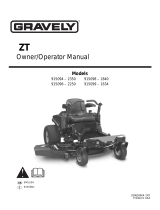 Gravely ZT 915096 – 2250 Owner's/Operator's Manual
Gravely ZT 915096 – 2250 Owner's/Operator's Manual
-
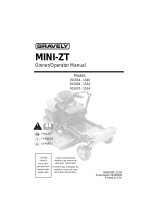 Gravely MINI-ZT 915064 Owner's/Operator's Manual
Gravely MINI-ZT 915064 Owner's/Operator's Manual
-
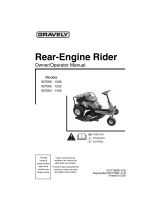 Gravely 927060-1028 User manual
Gravely 927060-1028 User manual
-
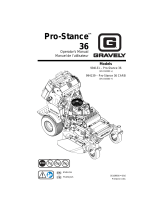 Gravely pro-stance 36 carb 994139 User manual
Gravely pro-stance 36 carb 994139 User manual
-
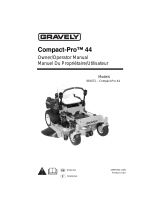 Gravely Compact-Pro 44 Specification
Gravely Compact-Pro 44 Specification
-
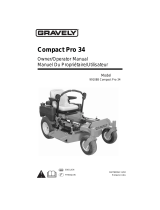 Gravely 99108 Compact Pro 34 User manual
Gravely 99108 Compact Pro 34 User manual
-
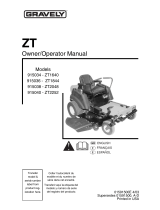 Gravely 915034 - ZT1640 Owner's/Operator's Manual
Gravely 915034 - ZT1640 Owner's/Operator's Manual
-
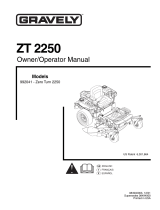 Gravely ZT 2250 Owner's And Operator's Manual
Gravely ZT 2250 Owner's And Operator's Manual
-
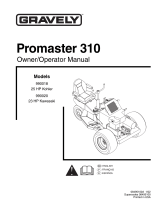 Gravely Promaster 310 User manual
Gravely Promaster 310 User manual
-
Gravely 992222 Owner's/Operator's Manual











































